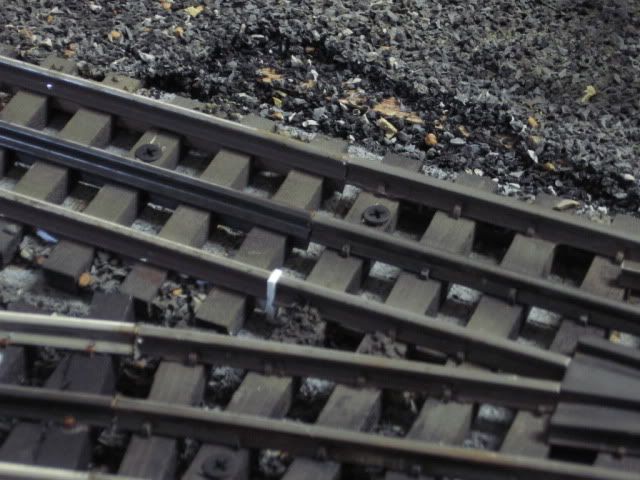How difficult is it to make the Ross tinplate switches antiderailing like the Lionel switches?
Thanks,
Ed Kazarian
|




|
How difficult is it to make the Ross tinplate switches antiderailing like the Lionel switches?
Thanks,
Ed Kazarian
Replies sorted oldest to newest
http://www.z-stuff.net/app27.html
I use the Z-Stuff 1008 Relay with my Ross switches and the DZ1000 switch motor and they work great.
I would assume it would work with the tinplate switches depending on the type of switch motor that is used,
Dan
Larry,
I read the instructions. So, I have to solder a wire to each 3 inch section as diagrammed to the switch machine. Is that correct?
Yes. R and L bottom diagram. Be sure that the 3" pieces are isolated/insulated from all other outside rail pieces including the switch frog.
I've added pieces of styrene to insulated these rail sections.

Note that if the two rail sections touch at the frog, I added another piece of styrene to separate them.
Wiring added with the track in place. This is a remodel project.

![]() Hope that helps, Best wishes with your project.
Hope that helps, Best wishes with your project.![]() Mike CT
Mike CT![]()
I use a spring loaded drawbar.....thus if a train enters switch thrown in either direction train throws it temp.
With the #8 turnouts, I wire the control rails on the turnout. The photo below shows a pair of turnouts that are controlled by 1 controller. At #1, hot glue is used to be sure the two control rails are insulated from each other. The arrows point to soldered joints. The control rails are pre drilled for the wires for ease of soldering.
I'm with AMCDave
Most of these solutions are probably above my pay grade and comfort level. I can solder a few wires but if I have to do diodes and relays, there is very little chance that I would get it right. Too bad Ross does not wire them up for the anti derailing at the factory.
Thanks to all who have discussed this so far.
Ed
The easiest way to make sure your trains don't derail on switches is to make sure the switch is lined properly before you run through it.
Gee...what a concept.
The easiest way to make sure your trains don't derail on switches is to make sure the switch is lined properly before you run through it.
Gee...what a concept.
what about a reversing loop?
Thanks Rich. That much I figured out myself. That wasn't the question I asked.
Ed
Ed,
To make the DZ-1000 non-derailing is pretty simple. As Ross' site states, you just need to add two wires. However, Ross' instructions leave a bit to be desired.
Below is my take on the diagram. You need to attached one wire to the L screw on the machine and solder it to the isolated rail on the thru track. Attached the other wire to the R screw and solder it to the turnout side rail. Check with a boxcar or other rolling stock to make sure it switches in the correct direction to prevent derailing. If it doesn't switch correctly, just switch the wires on the L and R screws.
I use the non-derailing function more for layout control. However, when I was running multiple trains between three loops on my old layout, I would sometimes forget to align a switch (or not get to it in time), so the non-derailing function was well worth it to me.
Thanks Ron! That seems pretty easy. Usually I align the switches properly but sometimes there are trains running all over the place with several operators and it's nice to know the trains will go through if someone forgot to throw a switch.
Ed
This video is a test run to see if all non-derail functions are working. The install is (2) Ross 204 three way switches. Note the flutter on occasion. The RY 44 tonner has to clear the isolated rail sections. Click on the triangle to acess the video.
Building a new layout with 22 Ross switches, including a wye and 2 double-slips that require relays. I would assume it's easier to wire for non-derail prior to laying switches. Also, how are the relays wired to prevent stalling ?
Mike
Mike,
What switch machines are you using? DZ-1000s, DZ-2500s, or something else. If a DZ, the Z Stuff website has lots of diagrams for various switches in various configurations. To help me out, I made some wiring diagrams for the DZ-2500 that I can follow a little better than Z Stuff's. I can send you these if you want, and you have Power Point.
Ron, I'm using DZ1000 machines and do have PP. Please send diagrams to me at: thorpe50@verizon.net
Mike
Mike, Thanks for the video. I really love what you're doing with the yard. I think I could spend hours moving cars around with what you have there. Terrific!
Ed
I've wired my Ross switches for nonderailing by using an insulating pin between the inside rail of the switch (leading to the frog) and the connecting track, instead of a separate 3" isolated rail leading to the switch, and nonderailing works well. However, I do have some issues with both Lionel Legacy and MTH PS3 locos losing power going through some of these switches below 10 SMPH. Could this wiring method be related to the lost power problem?
Access to this requires an OGR Forum Supporting Membership
